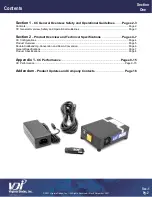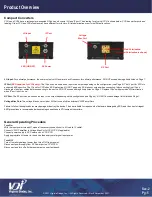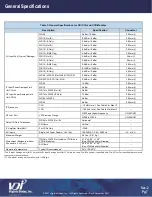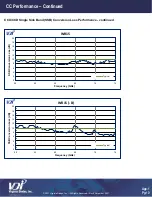
© 2021 Virginia Diodes, Inc.
—All Rights Reserved—Rev 8 November 2021
CCD: Block Down-Conversion
VDI CCDs can be used to down-convert a block of millimeter-wave / THz signals to the IF band, where it can then be coupled into
the RF port of an analyzer or processed by other means. Figure 1 shows how a VDI CCD down-converts a block of millimeter-
wave signals. It is important to note that due to the double sideband nature of the CCDs, the mixer will convert both sidebands.
The upper and lower sidebands will be down-converted to the same range IF output frequencies.
The IF Output frequency can be calculated by: f
IF
= | f
RF
– N•f
LO
|, N is the harmonic factor for the module. N=2 is shown in the
figure below.
Figure 1: Diagram of double-sideband block down-conversion is shown for subharmonic mixing.
CCU: Block Up-Conversion
The CCUs can also be used to up-convert a block of IF signals to generate a block of millimeter-wave / THz signals for
transmission from the RF port. Figure 2 shows how a VDI CCU up-converts a block of IF input signals. Due to the double
sideband nature of the CCUs, two sidebands (upper and lower sidebands) are generated during the up-conversion process. A
filter may be preferred for certain applications to eliminate one sideband. VDI offers a range of filters for common wireless
communication bands. Custom filters are also available upon request.
The lower sideband RF Output frequency can be calculated by: f
RF-lower
= N
•f
LO
– f
IF
. The upper sideband RF Output frequency
can be calculated by: f
RF-upper
= N
•f
LO
+ f
IF
, where N is the harmonic factor for the module. N=2 is shown in the figure below.
Figure 2: Diagram of double side-band block up-conversion is shown for subharmonic mixing.
Sec-2
Pg-6
Double Side-Band Up-Conversion and Down-Conversion
LO Input
IF Input
RF Output
LO Input
RF Input
IF Output


































